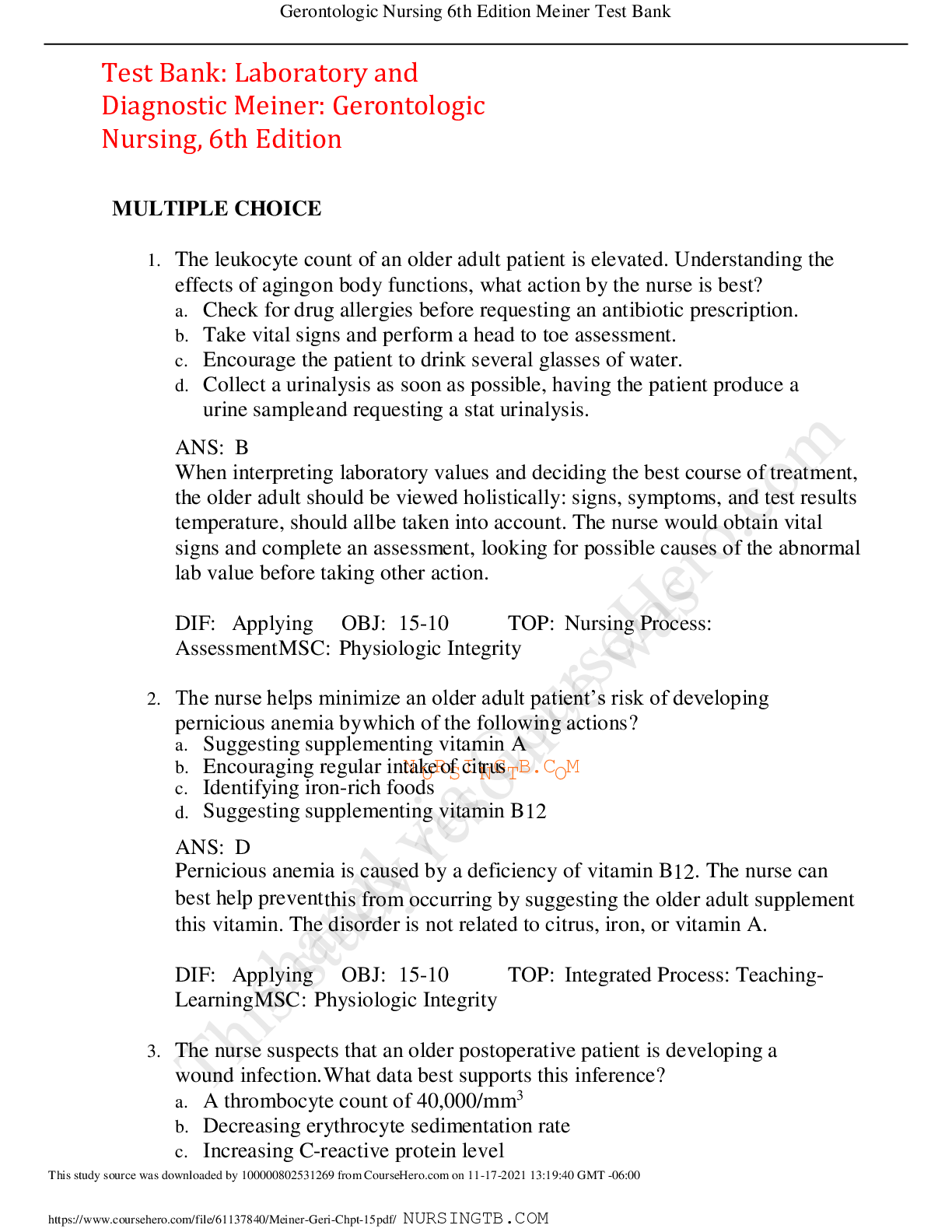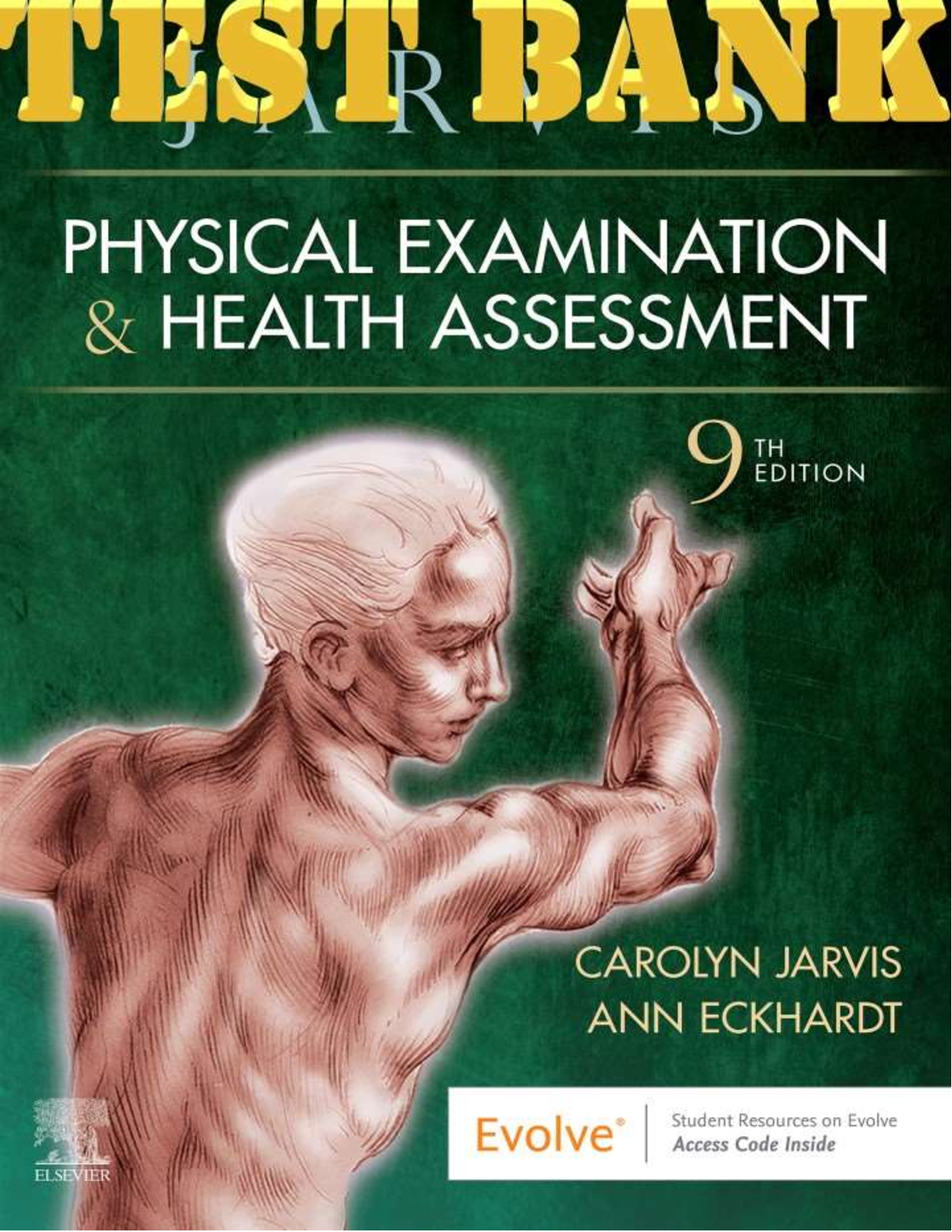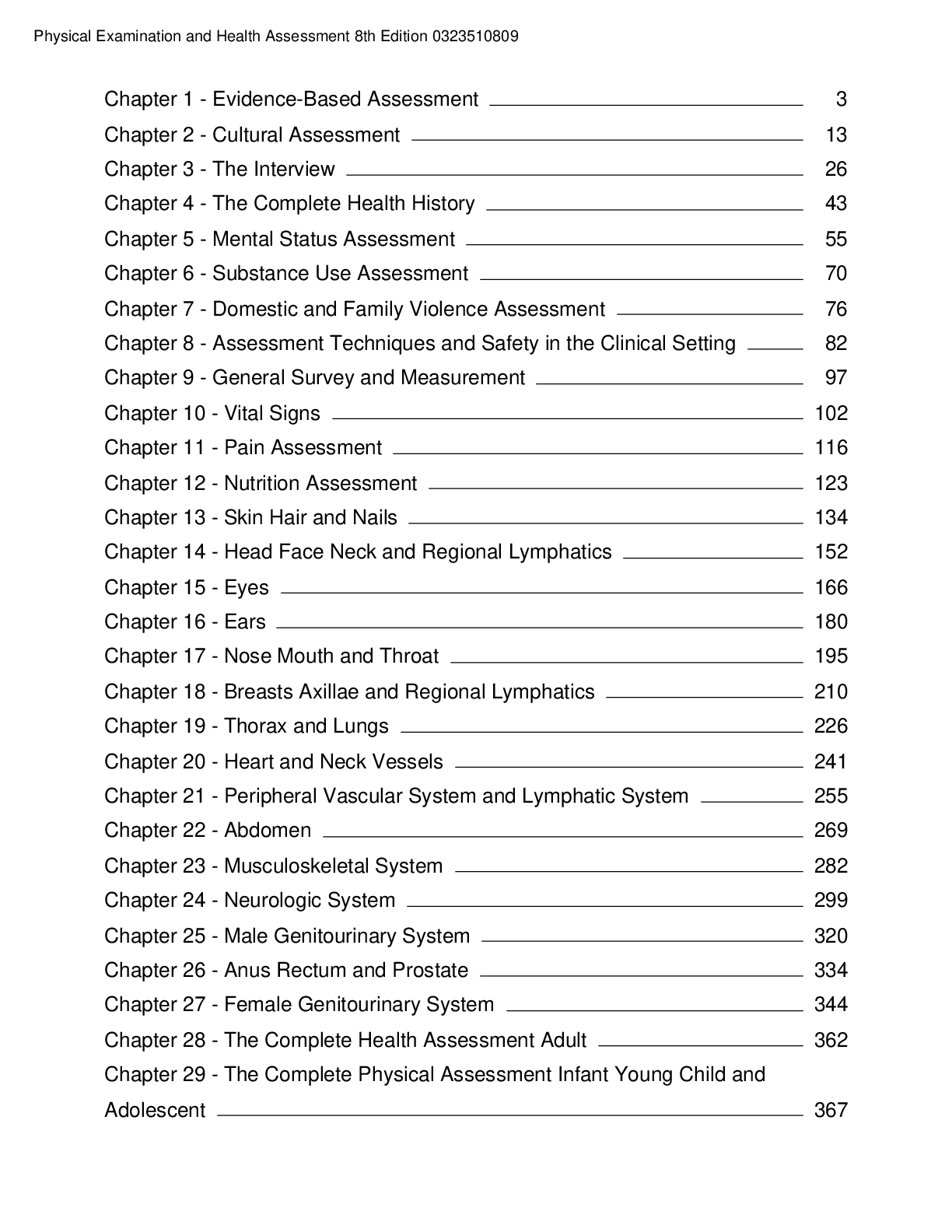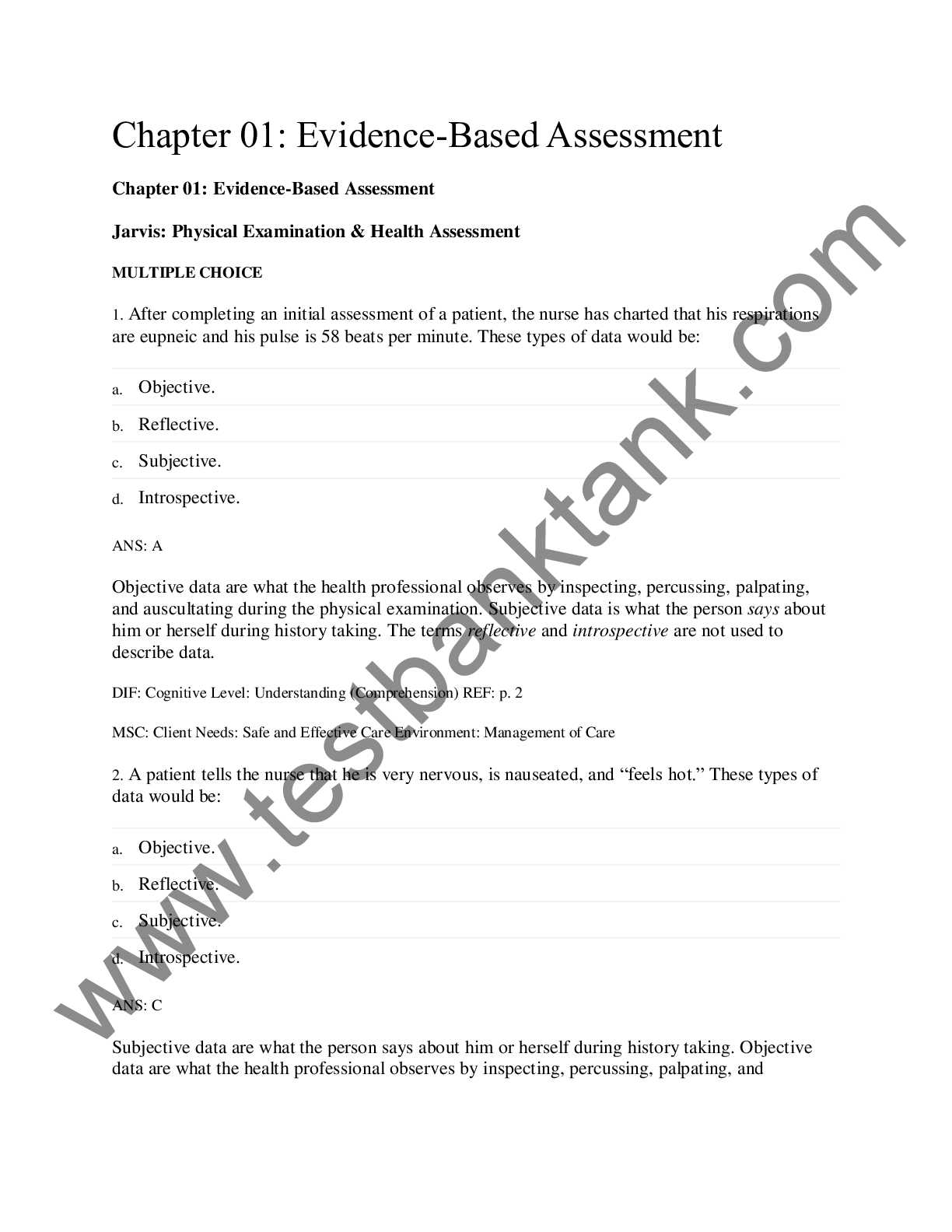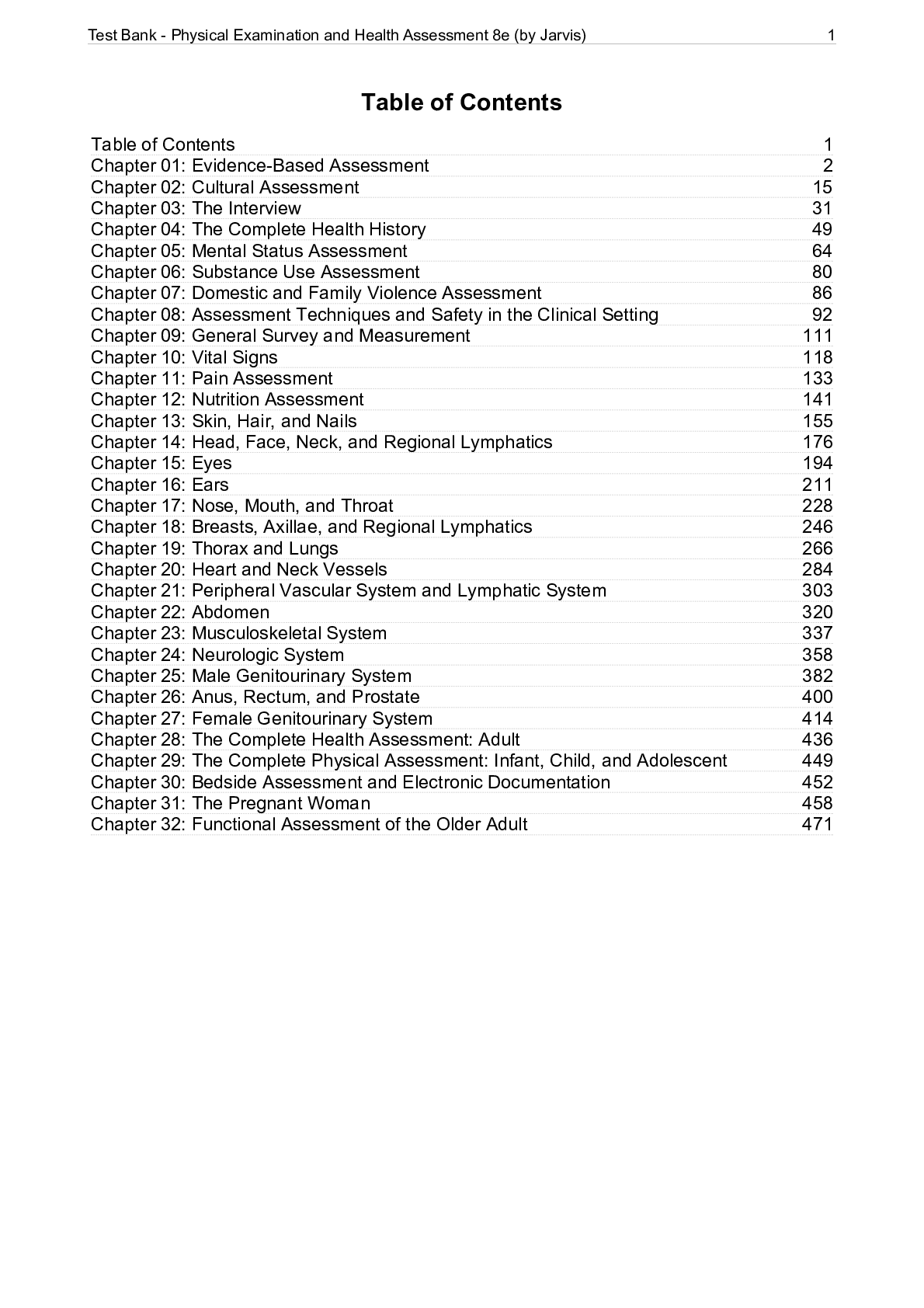*NURSING > TEST BANK > TEST BANK Chapter 10: Vital Signs PHYSICAL EXAMINATION AND HEALTH ASSESSMENT 8TH EDITION JARVIS ,100 (All)
TEST BANK Chapter 10: Vital Signs PHYSICAL EXAMINATION AND HEALTH ASSESSMENT 8TH EDITION JARVIS ,100% CORRECT
Document Content and Description Below
1. A patients weekly blood pressure readings for 2 months have ranged between 124/84 mm Hg and 136/88 mm Hg, with an average reading of 126/86 mm Hg. The nurse knows that this blood pressure falls wit... hin which blood pressure category? a. Normal blood pressure b. Prehypertension c. Stage 1 hypertension d. Stage 2 hypertension ANS: B According to the Seventh Report of the Joint National Committee (JNC 7) guidelines, prehypertension blood pressure readings are systolic readings of 120 to 139 mm Hg or diastolic readings of 50 to 89 mm Hg. DIF: Cognitive Level: Understanding (Comprehension) MSC: Client Needs: Safe and Effective Care Environment: Management of Care 2. When assessing an older adult, which vital NsiUgnRSchINanGgTeBs .oCcOcMur with aging? a. Increase in pulse rate b. Widened pulse pressure c. Increase in body temperature d. Decrease in diastolic blood pressure ANS: B With aging, the nurse keeps in mind that the systolic blood pressure increases, leading to widened pulse pressure. With many older people, both the systolic and diastolic pressures increase. The pulse rate and temperature do not increase. DIF: Cognitive Level: Understanding (Comprehension) MSC: Client Needs: Health Promotion and Maintenance 3. Which technique is correct when the nurse is assessing the radial pulse of a patient? The pulse is counted for: a. 1 minute, if the rhythm is irregular. b. 15 seconds and then multiplied by 4, if the rhythm is regular. c. 2 full minutes to detect any variation in amplitude. d. 10 seconds and then multiplied by 6, if the patient has no history of cardiac abnormalities. ANS: A Recent research suggests that the 30-second interval multiplied by 2 is the most accurate and efficient technique when heart rates are normal or rapid and when rhythms are regular. If the rhythm is irregular, then the pulse is counted for 1 full minute. DIF: Cognitive Level: Applying (Application) MSC: Client Needs: Safe and Effective Care Environment: Management of Care 4. When assessing a patients pulse, the nurse should also notice which of these characteristics? a. Force b. Pallor c. Capillary refill time d. Timing in the cardiac cycle NURSINGTB.COM ANS: A The pulse is assessed for rate, rhythm, and force. DIF: Cognitive Level: Understanding (Comprehension) MSC: Client Needs: Safe and Effective Care Environment: Management of Care 5. When assessing the pulse of a 6-year-old boy, the nurse notices that his heart rate varies with his respiratory cycle, speeding up at the peak of inspiration and slowing to normal with expiration. The nurses next action would be to: a. Immediately notify the physician. b. Consider this finding normal in children and young adults. c. Check the childs blood pressure, and note any variation with respiration. d. Document that this child has bradycardia, and continue with the assessment. ANS: B Sinus arrhythmia is commonly found in children and young adults. During the respiratory cycle, the heart rate varies, speeding up at the peak of inspiration and slowing to normal with expiration. DIF: Cognitive Level: Analyzing (Analysis) MSC: Client Needs: Health Promotion and Maintenance 6. When assessing the force, or strength, of a pulse, the nurse recalls that the pulse: a. Is usually recorded on a 0- to 2-point scale. b. Demonstrates elasticity of the vessel wall. c. Is a reflection of the hearts stroke volume. d. Reflects the blood volume in the arteries during diastole. ANS: C The heart pumps an amount of blood (the stroke volume) into the aorta. The force flares the arterial walls and generates a pressure wave, which is felt in the periphery as the pulse. DIF: Cognitive Level: Remembering (Knowledge) MSC: Client Needs: General 7. The nurse is assessing the vital signs of a 20-year-old male marathon runner and documents the following vital signs: temperature36 C; pulse48 beats per minute; respirations14 breaths per minute; blood pressure104/68 mm Hg. Which statement is true concerning these results? NURSINGTB.COM a. The patient is experiencing tachycardia. b. These are normal vital signs for a healthy, athletic adult. c. The patients pulse rate is not normalhis physician should be notified. d. On the basis of these readings, the patient should return to the clinic in 1 week. ANS: B In the adult, a heart rate less than 50 beats per minute is called bradycardia, which normally occurs in the well- trained athlete whose heart muscle develops along with the skeletal muscles. DIF: Cognitive Level: Analyzing (Analysis) MSC: Client Needs: Health Promotion and Maintenance 8. The nurse is assessing the vital signs of a 3-year-old patient who appears to have an irregular respiratory pattern. How should the nurse assess this childs respirations? a. Respirations should be counted for 1 full minute, noticing rate and rhythm. b. Childs pulse and respirations should be simultaneously checked for 30 seconds. c. Childs respirations should be checked for a minimum of 5 minutes to identify any variations in his or her respiratory pattern. d. Patients respirations should be counted for 15 seconds and then multiplied by 4 to obtain the number of respirations per minute. ANS: A Respirations are counted for 1 full minute if an abnormality is suspected. The other responses are not correct actions. DIF: Cognitive Level: Applying (Application) MSC: Client Needs: Health Promotion and Maintenance 9. A patients blood pressure is 118/82 mm Hg. He asks the nurse, What do the numbers mean? The nurses best reply is: a. The numbers are within the normal range and are nothing to worry about. b. The bottom number is the diastolic pressure and reflects the stroke volume of the heart. c. The top number is the systolic blood pressure and reflects the pressure of the blood against the arteries when the heart contracts. d. The concept of blood pressure is dNifUficRuSlItNtoGuTnBd.CerOstMand. The primary thing to be concerned about is the top number, or the systolic blood pressure. ANS: C The systolic pressure is the maximum pressure felt on the artery during left ventricular contraction, or systole. The diastolic pressure is the elastic recoil, or resting, pressure that the blood constantly exerts in between each contraction. The nurse should answer the patients question and use terms he can understand. DIF: Cognitive Level: Analyzing (Analysis) MSC: Client Needs: Safe and Effective Care Environment: Management of Care 10. While measuring a patients blood pressure, the nurse recalls that certain factors, such as , help determine blood pressure. a. Pulse rate b. Pulse pressure c. Vascular output d. Peripheral vascular resistance ANS: D The level of blood pressure is determined by five factors: cardiac output, peripheral vascular resistance, volume of circulating blood, viscosity, and elasticity of the vessel walls. DIF: Cognitive Level: Remembering (Knowledge) MSC: Client Needs: General 11. A nurse is helping at a health fair at a local mall. When taking blood pressures on a variety of people, the nurse keeps in mind that: a. After menopause, blood pressure readings in women are usually lower than those taken in men. b. The blood pressure of a Black adult is usually higher than that of a White adult of the same age. c. Blood pressure measurements in people who are overweight should be the same as those of people who are at a normal weight. d. A teenagers blood pressure reading will be lower than that of an adult. ANS: B In the United States, a Black adults blood pressure is usually higher than that of a White adult of the same age. The incidence of hypertension is twice as high in Blacks as it is in Whites. After menopause, blood pressure in women is higher than in men; blood pressure measurements in people who are obese are usually higher than in those who are not overweight. Normally, a gradual rise occurs through childhood and into the adult years. DIF: Cognitive Level: Applying (Application)NURSINGTB.COM MSC: Client Needs: Physiologic Integrity 12. The nurse notices a colleague is preparing to check the blood pressure of a patient who is obese by using a standard-sized blood pressure cuff. The nurse should expect the reading to: a. Yield a falsely low blood pressure. b. Yield a falsely high blood pressure. c. Be the same, regardless of cuff size. d. Vary as a result of the technique of the person performing the assessment. ANS: B Using a cuff that is too narrow yields a falsely high blood pressure because it takes extra pressure to compress the artery. DIF: Cognitive Level: Applying (Application) MSC: Client Needs: Safe and Effective Care Environment: Management of Care 13. A student is late for his appointment and has rushed across campus to the health clinic. The nurse should: a. Allow 5 minutes for him to relax and rest before checking his vital signs. b. Check the blood pressure in both arms, expecting a difference in the readings because of his recent exercise. c. Immediately monitor his vital signs on his arrival at the clinic and then 5 minutes later, recording any differences. d. Check his blood pressure in the supine position, which will provide a more accurate reading and will allow him to relax at the same time. ANS: A A comfortable, relaxed person yields a valid blood pressure. Many people are anxious at the beginning of an examination; the nurse should allow at least a 5-minute rest period before measuring blood pressure. DIF: Cognitive Level: Analyzing (Analysis) MSC: Client Needs: Safe and Effective Care Environment: Management of Care 14. The nurse will perform a palpated pressure before auscultating blood pressure. The reason for this is to: a. More clearly hear the Korotkoff sounds. b. Detect the presence of an auscultatory gap. NURSINGTB.COM c. Avoid missing a falsely elevated blood pressure. d. More readily identify phase IV of the Korotkoff sounds. ANS: B Inflation of the cuff 20 to 30 mm Hg beyond the point at which a palpated pulse disappears will avoid missing an auscultatory gap, which is a period when the Korotkoff sounds disappear during auscultation. DIF: Cognitive Level: Understanding (Comprehension) MSC: Client Needs: Safe and Effective Care Environment: Management of Care 15. The nurse is taking an initial blood pressure reading on a 72-year-old patient with documented hypertension. How should the nurse proceed? a. Cuff should be placed on the patients arm and inflated 30 mm Hg above the patients pulse rate. b. Cuff should be inflated to 200 mm Hg in an attempt to obtain the most accurate systolic reading. c. Cuff should be inflated 30 mm Hg above the point at which the palpated pulse disappears. d. After confirming the patients previous blood pressure readings, the cuff should be inflated 30 mm Hg above the highest systolic reading recorded. ANS: C An auscultatory gap occurs in approximately 5% of the people, most often in those with hypertension. To check for the presence of an auscultatory gap, the cuff should be inflated 20 to 30 mm Hg beyond the point at which the palpated pulse disappears. DIF: Cognitive Level: Analyzing (Analysis) MSC: Client Needs: Safe and Effective Care Environment: Management of Care 16. The nurse has collected the following information on a patient: palpated blood pressure180 mm Hg; auscultated blood pressure170/100 mm Hg; apical pulse60 beats per minute; radial pulse70 beats per minute. What is the patients pulse pressure? a. 10 b. 70 c. 80 d. ANS: B 100 Pulse pressure is the difference between systoNlicUaRnSdINdGiaTstBo.lCicObMlood pressure (170 100 = 70) and reflects the stroke volume. DIF: Cognitive Level: Applying (Application) MSC: Client Needs: Physiologic Integrity 17. When auscultating the blood pressure of a 25-year-old patient, the nurse notices the phase I Korotkoff sounds begin at 200 mm Hg. At 100 mm Hg, the Korotkoff sounds muffle. At 92 mm Hg, the Korotkoff sounds disappear. How should the nurse record this patients blood pressure? a. 200/92 b. 200/100 c. 100/200/92 d. ANS: A 200/100/92 In adults, the last audible sound best indicates the diastolic pressure. When a variance is greater than 10 to 12 mm Hg between phases IV and V, both phases should be recorded along with the systolic reading (e.g., 142/98/80). DIF: Cognitive Level: Analyzing (Analysis) MSC: Client Needs: Safe and Effective Care Environment: Management of Care 18. A patient is seen in the clinic for complaints of fainting episodes that started last week. How should the nurse proceed with the examination? a. Blood pressure readings are taken in both the arms and the thighs. b. The patient is assisted to a lying position, and his blood pressure is taken. c. His blood pressure is recorded in the lying, sitting, and standing positions. d. His blood pressure is recorded in the lying and sitting positions; these numbers are then averaged to obtain a mean blood pressure. ANS: C If the person is known to have hypertension, is taking antihypertensive medications, or reports a history of fainting or syncope, then the blood pressure reading should be taken in three positions: lying, sitting, and standing. DIF: Cognitive Level: Applying (Application) MSC: Client Needs: Safe and Effective Care Environment: Management of Care 19. A 70-year-old man has a blood pressure of 150/90 mm Hg in a lying position, 130/80 mm Hg in a sitting position, and 100/60 mm Hg in a standing position. How should the nurse evaluate these findings? NURSINGTB.COM a. These readings are a normal response and attributable to changes in the patients position. b. The change in blood pressure readings is called orthostatic hypotension. c. The blood pressure reading in the lying position is within normal limits. d. The change in blood pressure readings is considered within normal limits for the patients age. ANS: B Orthostatic hypotension is a drop in systolic pressure of more than 20 mm Hg, which occurs with a quick change to a standing position. Aging people have the greatest risk of this problem. DIF: Cognitive Level: Analyzing (Analysis) MSC: Client Needs: Health Promotion and Maintenance 20. The nurse is helping another nurse to take a blood pressure reading on a patients thigh. Which action is correct regarding thigh pressure? a. Either the popliteal or femoral vessels should be auscultated to obtain a thigh pressure. b. The best position to measure thigh pressure is the supine position with the knee slightly bent. c. If the blood pressure in the arm is high in an adolescent, then it should be compared with the thigh pressure. d. The thigh pressure is lower than the pressure in the arm, which is attributable to the distance away from the heart and the size of the popliteal vessels. ANS: C When blood pressure measured at the arm is excessively high, particularly in adolescents and young adults, it is compared with thigh pressure to check for coarctation of the aorta. The popliteal artery is auscultated for the reading. Generally, thigh pressure is higher than that of the arm; however, if coarctation of the artery is present then arm pressures are higher than thigh pressures. DIF: Cognitive Level: Understanding (Comprehension) MSC: Client Needs: Safe and Effective Care Environment: Management of Care 21. A 4-month-old child is at the clinic for a well-baby check-up and immunizations. Which of these actions is most appropriate when the nurse is assessing an infants vital signs? a. The infants radial pulse should be palpated, and the nurse should notice any fluctuations resulting from activity or exercise. b. The nurse should auscultate an apical rate for 1 minute and then assess for any normal irregularities, such as sinus arrhythmia. c. The infants blood pressure should NbeUaRsSsIeNssGeTdBb.yCOusMing a stethoscope with a large diaphragm piece to hear the soft muffled Korotkoff sounds. d. The infants chest should be observed and the respiratory rate counted for 1 minute; the respiratory pattern may vary significantly. ANS: B The nurse palpates or auscultates an apical rate with infants and toddlers. The pulse should be counted for 1 full minute to account for normal irregularities, such as sinus arrhythmia. Children younger than 3 years of age have such small arm vessels; consequently, hearing Korotkoff sounds with a stethoscope is difficult. The nurse should use either an electronic blood pressure device that uses oscillometry or a Doppler ultrasound device to amplify the sounds. DIF: Cognitive Level: Applying (Application) MSC: Client Needs: Safe and Effective Care Environment: Management of Care 22. The nurse is conducting a health fair for older adults. Which statement is true regarding vital sign measurements in aging adults? a. The pulse is more difficult to palpate because of the stiffness of the blood vessels. b. An increased respiratory rate and a shallower inspiratory phase are expected findings. c. A decreased pulse pressure occurs from changes in the systolic and diastolic blood pressures. d. Changes in the bodys temperature regulatory mechanism leave the older person more likely to develop a fever. ANS: B Aging causes a decrease in vital capacity and decreased inspiratory reserve volume. The examiner may notice a shallower inspiratory phase and an increased respiratory rate. An increase in the rigidity of the arterial walls makes the pulse actually easier to palpate. Pulse pressure is widened in older adults, and changes in the body temperature regulatory mechanism leave the older person less likely to have fever but at a greater risk for hypothermia. DIF: Cognitive Level: Understanding (Comprehension) MSC: Client Needs: Health Promotion and Maintenance 23. In a patient with acromegaly, the nurse will expect to discover which assessment findings? a. Heavy, flattened facial features b. Growth retardation and a delayed onset of puberty c. Overgrowth of bone in the face, head, hands, and feet d. Increased height and weight and delayed sexual development NURSINGTB.COM ANS: C Excessive secretions of growth hormone in adulthood after normal completion of body growth causes an overgrowth of the bones in the face, head, hands, and feet but no change in height. DIF: Cognitive Level: Understanding (Comprehension) MSC: Client Needs: Safe and Effective Care Environment: Management of Care 24. The nurse is assessing children in a pediatric clinic. Which statement is true regarding the measurement of blood pressure in children? a. Blood pressure guidelines for children are based on age. b. Phase II Korotkoff sounds are the best indicator of systolic blood pressure in children. c. Using a Doppler device is recommended for accurate blood pressure measurements until adolescence. d. The disappearance of phase V Korotkoff sounds can be used for the diastolic reading in children. ANS: D The disappearance of phase V Korotkoff sounds can be used for the diastolic reading in children, as well as in adults. DIF: Cognitive Level: Remembering (Knowledge) MSC: Client Needs: Health Promotion and Maintenance 25. What type of blood pressure measurement error is most likely to occur if the nurse does not check for the presence of an auscultatory gap? a. Diastolic blood pressure may not be heard. b. Diastolic blood pressure may be falsely low. c. Systolic blood pressure may be falsely low. d. Systolic blood pressure may be falsely high. ANS: C If an auscultatory gap is undetected, then a falsely low systolic or falsely high diastolic reading may result, which is common in patients with hypertension. DIF: Cognitive Level: Understanding (Comprehension) MSC: Client Needs: Safe and Effective Care Environment: Management of Care 26. When considering the concepts related to blood pressure, the nurse knows that the concept of mean arterial pressure (MAP) is best described by which statement? NURSINGTB.COM a. MAP is the pressure of the arterial pulse. b. MAP reflects the stroke volume of the heart. c. MAP is the pressure forcing blood into the tissues, averaged over the cardiac cycle. d. MAP is an average of the systolic and diastolic blood pressures and reflects tissue perfusion. ANS: C MAP is the pressure that forces blood into the tissues, averaged over the cardiac cycle. Stroke volume is reflected by the blood pressure. MAP is not an arithmetic average of systolic and diastolic pressures because diastole lasts longer; rather, it is a value closer to diastolic pressure plus one third of the pulse pressure. DIF: Cognitive Level: Remembering (Knowledge) MSC: Client Needs: Safe and Effective Care Environment: Management of Care 27. A 75-year-old man with a history of hypertension was recently changed to a new antihypertensive drug. He reports feeling dizzy at times. How should the nurse evaluate his blood pressure? a. Blood pressure and pulse should be recorded in the supine, sitting, and standing positions. b. The patient should be directed to walk around the room and his blood pressure assessed after this activity. c. Blood pressure and pulse are assessed at the beginning and at the end of the examination. d. Blood pressure is taken on the right arm and then 5 minutes later on the left arm. ANS: A Orthostatic vital signs should be taken when the person is hypertensive or is taking antihypertensive medications, when the person reports fainting or syncope, or when volume depletion is suspected. The blood pressure and pulse readings are recorded in the supine, sitting, and standing positions. DIF: Cognitive Level: Applying (Application) MSC: Client Needs: Safe and Effective Care Environment: Management of Care 28. Which of these specific measurements is the best index of a childs general health? a. Vital signs b. Height and weight c. Head circumference d. Chest circumference NURSINGTB.COM ANS: B Physical growth, measured by height and weight, is the best index of a childs general health. DIF: Cognitive Level: Understanding (Comprehension) MSC: Client Needs: Health Promotion and Maintenance 29. The nurse is assessing an 8-year-old child whose growth rate measures below the third percentile for a child his age. He appears significantly younger than his stated age and is chubby with infantile facial features. Which condition does this child have? a. Hypopituitary dwarfism b. Achondroplastic dwarfism c. Marfan syndrome d. Acromegaly ANS: A Hypopituitary dwarfism is caused by a deficiency in growth hormone in childhood and results in a retardation of growth below the third percentile, delayed puberty, and other problems. The childs appearance fits this description. Achondroplastic dwarfism is a genetic disorder resulting in characteristic deformities; Marfan syndrome is an inherited connective tissue disorder characterized by a tall, thin stature and other features. Acromegaly is the result of excessive secretion of growth hormone in adulthood. DIF: Cognitive Level: Applying (Application) MSC: Client Needs: Safe and Effective Care Environment: Management of Care 30. The nurse is counting an infants respirations. Which technique is correct? a. Watching the chest rise and fall b. Watching the abdomen for movement c. Placing a hand across the infants chest d. Using a stethoscope to listen to the breath sounds ANS: B Watching the abdomen for movement is the correct technique because the infants respirations are normally more diaphragmatic than thoracic. The other responses do not reflect correct techniques. DIF: Cognitive Level: Analyzing (Analysis) MSC: Client Needs: Health Promotion and Maintenance NURSINGTB.COM 31. When checking for proper blood pressure cuff size, which guideline is correct? a. The standard cuff size is appropriate for all sizes. b. The length of the rubber bladder should equal 80% of the arm circumference. c. The width of the rubber bladder should equal 80% of the arm circumference. d. The width of the rubber bladder should equal 40% of the arm circumference. ANS: D The width of the rubber bladder should equal 40% of the circumference of the persons arm. The length of the bladder should equal 80% of this circumference. DIF: Cognitive Level: Applying (Application) MSC: Client Needs: Safe and Effective Care Environment: Management of Care 32. During an examination, the nurse notices that a female patient has a round moon face, central trunk obesity and a cervical hump. Her skin is fragile with bruises. The nurse determines that the patient has which condition? a. Marfan syndrome b. Gigantism c. Cushing syndrome d. Acromegaly ANS: C Cushing syndrome is characterized by weight gain and edema with central trunk and cervical obesity (buffalo hump) and round plethoric face (moon face). Excessive catabolism causes muscle wasting; weakness; thin arms and legs; reduced height; and thin, fragile skin with purple abdominal striae, bruising, and acne. DIF: Cognitive Level: Applying (Application) MSC: Client Needs: Safe and Effective Care Environment: Management of Care 33. The nurse is preparing to measure the vital signs of a 6-month-old infant. Which action by the nurse is correct? a. Respirations are measured; then pulse and temperature. b. Vital signs should be measured more frequently than in an adult. c. Procedures are explained to the parent, and the infant is encouraged to handle the equipment. NURSINGTB.COM d. The nurse should first perform the physical examination to allow the infant to become more familiar with her and then measure the infants vital signs. ANS: A With an infant, the order of vital sign measurements is reversed to respiration, pulse, and temperature. Taking the temperature first, especially if it is rectal, may cause the infant to cry, which will increase the respiratory and pulse rate, thus masking the normal resting values. The vital signs are measured with the same purpose and frequency as would be measured in an adult. DIF: Cognitive Level: Applying (Application) MSC: Client Needs: Safe and Effective Care Environment: Management of Care MULTIPLE RESPONSE 1. While measuring a patients blood pressure, the nurse uses the proper technique to obtain an accurate reading. Which of these situations will result in a falsely high blood pressure reading? Select all that apply. a. The person supports his or her own arm during the blood pressure reading. b. The blood pressure cuff is too narrow for the extremity. c. The arm is held above level of the heart. d. The cuff is loosely wrapped around the arm. e. The person is sitting with his or her legs crossed. f. The nurse does not inflate the cuff high enough. ANS: A, B, D, E Several factors can result in blood pressure readings that are too high or too low. Having the patients arm held above the level of the heart is one part of the correct technique. DIF: Cognitive Level: Applying (Application) MSC: Client Needs: Safe and Effective Care Environment: Management of Care SHORT ANSWER 1. What is the pulse pressure for a patient whose blood pressure is 158/96 mm Hg and whose pulse rate is 72 beats per minute? ANS: 62 The pulse pressure is the difference between the systolic and diastolic and reflects the stroke volume. The pulse rate is not necessary for pulse pressure calculations. DIF: Cognitive Level: Analyzing (Analysis) MSC: Client Needs: Safe and Effective Care ENnUvRirSoInNmGeTnBt:.CMOaMnagement of Care [Show More]
Last updated: 1 year ago
Preview 1 out of 21 pages
Instant download

Buy this document to get the full access instantly
Instant Download Access after purchase
Add to cartInstant download
Reviews( 0 )
Document information
Connected school, study & course
About the document
Uploaded On
Feb 17, 2021
Number of pages
21
Written in
Additional information
This document has been written for:
Uploaded
Feb 17, 2021
Downloads
0
Views
52










